- Bernard Preston homepage
- Yellows
- Pumpkin for Diabetes
Pumpkin for diabetes
Pumpkin for diabetes not only lowers raised blood glucose quickly and effectively but insulin use is also significantly reduced. Two active ingredients have been isolated; one is vitamin B3 and the other trigonelline. Their chemical structures are similar. There may well be more nutrients that at this point are still unknown.
The high fibre content is certainly part of the equation; that slows gastric emptying and the absorption of the starch in the small-intestine where sugars are formed by enzyme action.
Pumpkin in fact has a fairly high glycemic index but because the amount of carbohydrate is so low, it has no detrimental effect on diabetics provided they don't eat too much. In fact, it is highly beneficial, thanks to the nicotinic-acid and trigonelline.
Pumpkin thus has a very low glycemic load; despite the high GI.
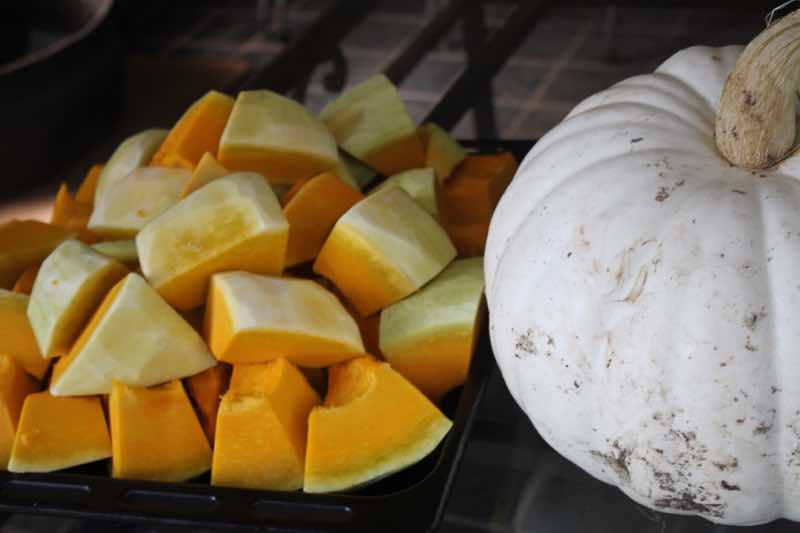
It also forms a solid confirmation that those who eat many highly-coloured foods like pumpkins, greens and berries are much less sickly.
In fact those enjoying 8 coloured foods every day have a 33% lower all-cause of death; that's massive. Part of the reason is that insulin resistance is far better controlled.
"Diabetes is one of the most common chronic conditions affecting 15% of adults enjoying typical grocery store food. Nearly one-third of people over 65 years are afflicted."
The pumpkin family, Curcubita Maxima, is actually used in many countries as a traditional remedy for diabetes. We suspect that those enjoying whole, unrefined starches like these on a regular basis actually are less likely to get the disease but that remains to be proved.
The seeds too are rich in protein, vitamins and the good fats.
Jessica Gavin will show you how to roast pumpkin seeds; very easily done without having to peel them[6].
In general roasting increases the GI of starches so it is better to enjoy the pumpkin baked or boiled.
That science
Blood glucose
Before pumpkin
After pumpkin
mg/dl
215
178
Mmol/l
12.0
9.9
Scientists reporting in the Advanced Pharmaceutical Bulletin studied the effect of a pumpkin extract for diabetes on 20 critically-ill patients who were admitted to ICU; they found that in the three days prior to being given the formulation their blood glucose was on average 215 mg/dl.
After being given the pumpkin extract twice a day, their blood glucose dropped to 178 on average. Moreover insulin use decreased from 48 IU to 40[1].
Complications of diabetes
- Microvascular complications: kidney disease, blindness and peripheral neuropathy.
- Macrovascular complications: coronary artery conditions, stroke and peripheral artery disease.
- In the elderly: cancer, infections and early cognitive decline.
Mild cognitive decline occurs in roughly 15 percent of adults; in diabetics there is a prevalence of 45pc. Chronically raised blood glucose raises the risk of losing your marbles by a factor of 3.
Nearly one-third of people over 65 years have diabetes; one in nine have Alzheimer's Disease. They are closely connected.
Furthermore scientists reporting in the Journal of Nutritional
Research showed that consumption of 65g of pumpkin seeds, about 4 tablespoons with a high
carbohydrate meal reduced the average blood glucose spike by 35%[2].
Other scientists after discovering that pumpkin maintained a lower blood glucose level than a control group, isolated the active ingredients; vitamin B3 and another compound called trigonelline[3].
Butternut
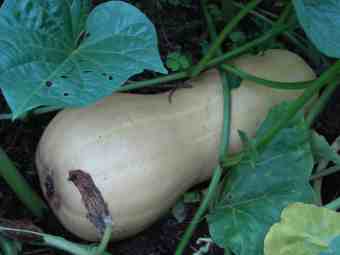
Butternut also belongs to the Cucurbita family and would be our first choice in the pumpkin-family for diabetes management. Turned so easily into a delicious soup it is in fact on the menu at our green home several times a week for more than half the year.
Butternut has a much lower GI than pumpkin.
Planted in a compost-heap they grow to a very large size with no loss of flavour.
This easy butternut soup is simple to make, especially if you have a pressure cooker. Best they are left to lie in the garden until they have turned a nutty-brown colour; and the plant has completely dried off.
Growing butternut squash is only for those with a large garden. It becomes rampant and will shade out other plants unless controlled.
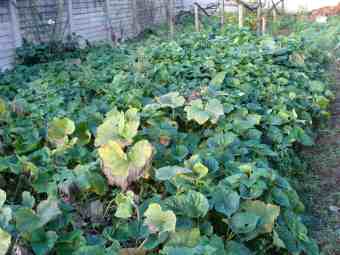
Glycemic load (GL)
The glycemic load (GL) is really a better way of determining the effect of a carbohydrate on blood sugar. It is an index that combines the GI with the amount of starch in a serving.
A carbohydrate with a GL of less than 10 has little effect on blood-glucose. That of half a cup of pumpkin is 3; very low.
However GL is also determined by portion size. Enjoy a large serving of pumpkin and it will certainly have a high carb load; and may effect the blood-glucose negatively. In any event it contributes a lot of starch to the meal; do not have potatoes or bread with your soup.
Half a cup of pumpkin (100g) contains 11 grams of carbohydrate + 3 of sugars = 14; 3.5 of them are fibre which would pass through the small intestine undigested to the colon.
That fibre also contributes to the feeling of fullness after eating that is often described as satiety.
Diabetics should keep their total carbohydrate to less than 50 grams per day; and half of that if they are unstable, or wanting to lose weight.
In short pumpkin for diabetics is excellent in small portions but could be detrimental if you ate a lot.
Portion control is vital; half a cup max. That would also give you a significant amount of beta-carotene.
The glycemic-index of butternut at 51 is much lower than that of pumpkin but the load is the same; GL of 3 in half a cup.
Pancreatic cancer
Pancreatic cancer is projected to become the No. 2 cause of malignant tumour-related death in the United States, according to Cedars Sinai. Diabetes and weight loss medications lie centre stage.
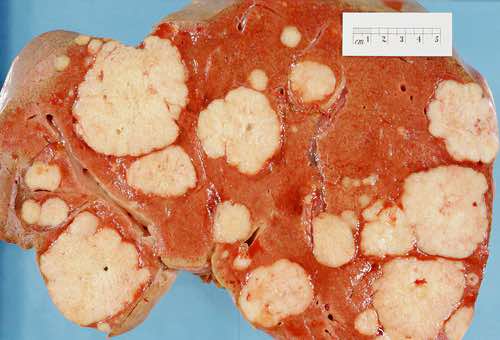 Pancreatic cancer is increasing by 11% each decade
Pancreatic cancer is increasing by 11% each decadeThe risk factors of pancreatic cancer are as follows:
- Pancreatitis increases the risk by almost fourfold.
- Incretin hormone agonist medication increases the risk ninefold.
- Diabetes mellitus
increases risk by 2.5-fold.
- Gall bladder related disease increases the risk by twofold[7].
Newsletter
Our newsletter is entitled "create a cyan zone" at your home, preserving both yourself and Mother Earth for future generations; and the family too, of course. We promise not to spam you with daily emails promoting various products. You may get an occasional nudge to buy one of my books.
Here are the back issues.
- Lifestyle and ideal body weight
- What are ultra-processed foods?
- Investing in long-term health
- Diseases from plastic exposure
- Intensive lifestyle management for obesity has limited value
- A world largely devoid of Parkinson's Disease
- The impact of friendly bacteria in the tum on the prevention of cancer
- There's a hole in the bucket
- Everyone is talking about weight loss drugs
- Pull the sweet tooth
- If you suffer from heartburn plant a susu
- Refined maize meal and stunting
- Should agriculture and industry get priority for water and electricity?
- Nature is calling
- Mill your own flour
- Bake your own sourdough bread
- Microplastics from our water
- Alternative types of water storage
- Wear your clothes out
- Comfort foods
- Create a bee-friendly environment
- Go to bed slightly hungry
- Keep bees
- Blue zone folk are religious
- Reduce plastic waste
- Family is important
- What can go in compost?
- Grow broad beans for longevity
- Harvest and store sunshine
- Blue zone exercise
- Harvest and store your rainwater
- Create a cyan zone at your home
Trigonelline
For those with a chemistry background, trigonelline is a pyridine; its structure is a benzene ring with an N replacing one of the carbons.
Nicotinic acid (niacin, or vitamin B3) is also a pyridine derivative.
The scientists found that these two compounds affected enzyme action in the liver positively, keeping blood glucose down.
They also lower triglycerides in both the liver and blood stream.
Diabetic retinopathy
"26% of those living with diabetes are going blind from retinopathy."
Diabetic retinopathy is a serious disease and the prevalence in many Western countries is very high; 1 in 29 Americans, for example. In one quarter of these people it is catastrophic.
Globally nearly one quarter of diabetics suffer from diabetic retinopathy; in North America, Africa and the Caribbean it affects over a third of those suffering from the disease[4].
There are different causes; some can be treated fairly adequately but there is no successful or approved care for others such as diabetic macular ischemia. In one study 42% of those suffering from T2D had this type; progressive loss of vision is inevitable[5].
Strict control of blood glucose appears to be the only solution; pumpkin for diabetes is just one small part of the therapy. Enjoy it regularly, in small portions to reduce the glycemic load.
Cancer
Diabetes increases the risk of many cancers, especially of the liver, pancreas and breast; colon and prostate too. The chronic inflammation of raised blood glucose causes oxidative stress which damages our DNA.
The big idea
It is refined carbs and not all starches that are the villain of the peace when it comes to obesity and diabetes.
However unrefined grains are hard to come by. We recommend small amounts of brown rice, corn on the cob and grits; and bread made from 100% flour, if you can find it.
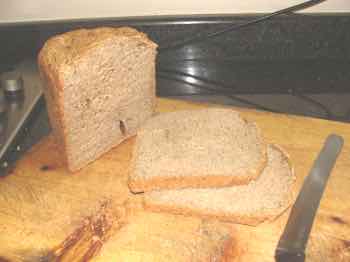 Sourdough bread made with 100% real flour.
Sourdough bread made with 100% real flour.Pumpkin pie
Most pumpkin-pie recipes lose the plot by adding more than a cup of sugar. It is already verboten for diabetics; and it's far too sweet. Try adding just 3 teaspoons of natural honey and a 1 TBSP of hummus instead of highly glycemic cornstarch for thickening. Cinnamon has an additional role to play in this traditional favourite.
Aquafaba is a topic of interest. The water used to cook legumes is an excellent emulsifier and coagulant; and can be used in place of egg-white and other thickening agents.
Pumpkin for diabetics in small portions remains central to good management of blood glucose.
"50% of patients will develop kidney disease after living with diabetes for 20 years. Referral to dialysis and transplant upon progression to end-stage renal failure is recommended."
Pumpkin for diabetes
Pumpkin for diabetes is grounded in strong science. Enjoy it regularly in small amounts, especially if you are overweight.
TIAs are warning shots of a future stroke, often within days. Butternut and pumpkin for diabetes is recommended both as prevention and treatment.
“It was time to take the pumpkin out of the pot and eat it. In the final analysis, that was what solved these big problems of life.
You could ponder, think and get nowhere but you still had to eat your pumpkin.
That brought you down to earth. That gave you a reason for going on; Pumpkin.”
- Dr Alexander McCall Smith
Fast facts
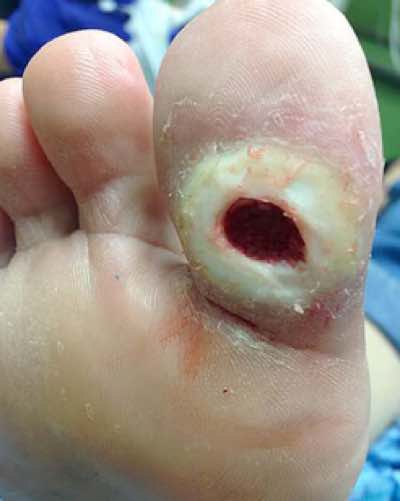 Diabetic foot ulcer
Diabetic foot ulcerComplications of diabetes
Diabetes is the most common chronic condition in countries where typical grocery store food is consumed, affecting 15% of adults and nearly one-third of those over 65.
The complications of diabetes[8] are awesome reaching to every part of the body. It behooves us to take this seriously; otherwise great suffering and an early demise lie ahead.
- The prevalence of diabetes mellitus, especially type 2, is rapidly increasing.
- Diabetic retinopathy is especially high in countries consuming large amounts of sugar and refined carbs.
- Pumpkin is one part of the solution.
Carb-loving gene
Studies on very early man, nearly a million years ago, already had a gene that would produce amylase, the enzyme that breaks down starch in the mouth and the small intestine.
Sweet-tasting amylose is initially formed; two glucose molecules joined.
However as the centuries passed with increasing amounts of carb in the diet, more copies of the gene are being found in modern man. This has made us very efficient digesters of starches; with consequent rise in blood glucose.
There are now nine copies of the gene that rapidly form amylase in the saliva. That gets us hooked on the sweet taste of food very quickly; nearly 10% of the starch is digested in the mouth. This leads to carb craving.
However it would appear that has only become a problem since food industrialists started refining carbs, removing the bran and other fibre. Gastric emptying is speeded up, glucose being formed very quickly in our extremely long and efficient small intestines.
Scientists are describing our modern processed carbs as "calorie-dense and nutritionally barren."
Fortunately we don't have to give up carbs, only those that have been processed; otherwise it's daily consumption of pumpkin for diabetes.
On a personal note
I am myself prediabetic; hence my consuming interest in pumpkin for diabetes. Via the regular consumption of butternut, short walks after every starchy meal and totally eschewing all refined carbs, I have managed to get my A1c down to 5.4; the average blood glucose over two months. That's entirely normal.
From the horse's mouth
- Effect of Cucurbita Maxima on Control of Blood Glucose in Diabetic Critically-Ill Patients
- Addition of pooled pumpkin seed to mixed meals reduced postprandial glycemia: a randomized placebo-controlled clinical trial
- Anti-diabetic effects of pumpkin and its components, trigonelline and nicotinic acid (B3)
- Global Prevalence of Diabetic Retinopathy and Projection of Burden through 2045
- Why Is Continued Vision Loss Still a Problem in Some Patients With Diabetic Retinopathy, Despite Treatment?
- How to roast pumpkin seeds
- New Model Predicts Pancreatic Cancer Risk
- Complications of Diabetes
When browsing use right click and Open Link in New Tab, or you may get a bad gateway signal.
Did you find this page interesting? How about forwarding it to a friendly book or food junkie? Better still, a social media tick would help.
- Bernard Preston homepage
- Yellows
- Pumpkin for Diabetes
Address:
56 Groenekloof Rd,
Hilton, KZN
South Africa
Website:
https://www.bernard-preston.com